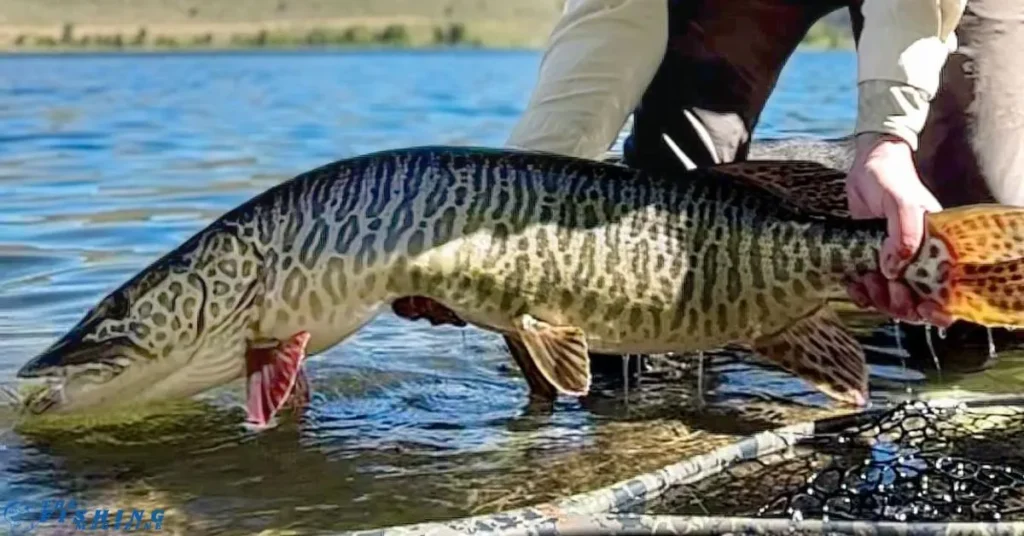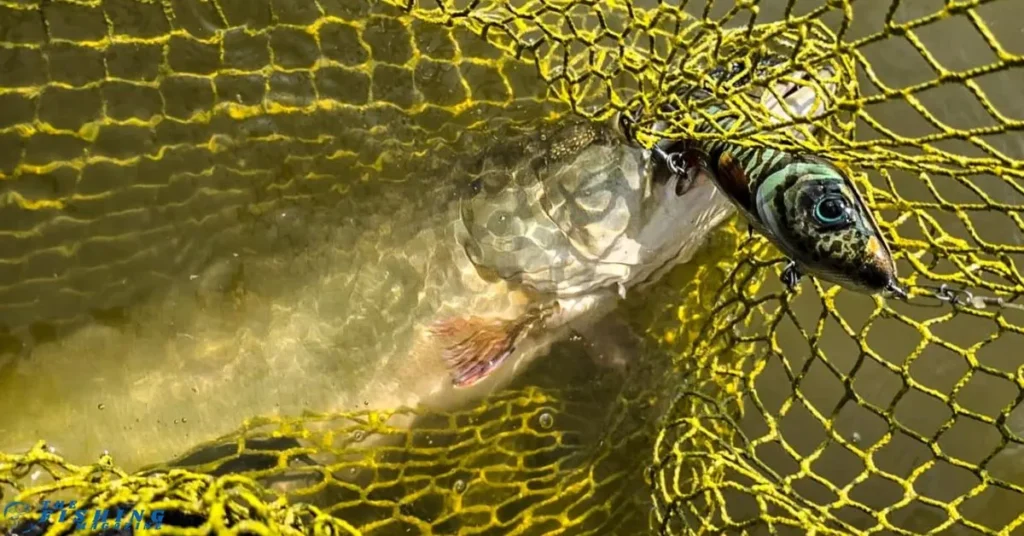Tiger Muskie fishing can be one of the most thrilling experiences an angler can have. These fierce, powerful predators are known for their aggressive strikes and formidable size, making them a sought-after prize for both novice and experienced fishermen.
But how do you go about catching this elusive fish? In this comprehensive guide, we’ll walk you through everything you need to know about how to fish for tiger muskie, from understanding their behavior to choosing the right gear and techniques.
Introduction
When it comes to freshwater fishing, few experiences compare to the excitement of hooking a tiger muskie. These fish are not only known for their size, often reaching over 50 inches, but also for their tenacity. A tiger muskie fight can be intense, making every moment on the water an adrenaline-filled adventure.
But catching a tiger muskie isn’t easy. They are known as the “fish of 10,000 casts” for a reason. This guide aims to arm you with the knowledge and tips you need to increase your chances of success.
We’ll cover where to find tiger muskie, the best times to fish for them, the equipment you’ll need, and the most effective techniques to use.
By the time you finish reading, you’ll be ready to hit the water with confidence and, hopefully, come away with a story about the one that didn’t get away.
Understanding Tiger Muskie Behavior
What is a Tiger Muskie?
Before we dive into the tactics, it’s essential to understand what exactly a tiger muskie is. The tiger muskie is a hybrid fish, a cross between a muskellunge (muskie) and a northern pike.
This combination results in a fish that possesses the best qualities of both species: the speed and agility of a pike and the size and power of a muskie.
Tiger muskies are sterile, meaning they cannot reproduce. As a result, they are often stocked in lakes and reservoirs to control fish populations and offer anglers a challenging target.
Habitat: Where to Find Tiger Muskie
Tiger muskies prefer clear, cool waters with plenty of structure. They can often be found in lakes and reservoirs with abundant weed beds, rocky outcrops, and submerged timber.
These structures provide cover and ambush points for tiger muskies, which are ambush predators by nature.
During the warmer months, tiger muskies are likely to be found in deeper waters, especially near drop-offs or ledges. As the water cools in the fall, they tend to move into shallower areas, making them more accessible to anglers.
Feeding Habits
Understanding the feeding habits of tiger muskie is crucial for successful fishing. These fish are opportunistic feeders, preying on a variety of species including perch, suckers, and even smaller pike.
Their diet largely depends on what’s available in their environment, but they are known for their preference for larger prey.
Tiger muskies are most active during low-light conditions, such as early morning, late evening, and overcast days. They are also more likely to feed when the water is cooler, making spring and fall prime seasons for muskie fishing.

Choosing the Right Gear for Tiger Muskie Fishing
Rods and Reels
When targeting tiger muskie, having the right rod and reel is essential due to the size and strength of these fish. Here’s what to look for:
- Rod: A medium-heavy to heavy-action rod, typically around 7 to 9 feet long, is ideal for muskie fishing. The length allows for longer casts and better control when fighting a large fish. A stiff rod helps in setting the hook firmly into the hard mouth of a muskie.
- Reel: A baitcasting reel with a strong drag system is preferred. You’ll want a reel with a high gear ratio (6:1 or higher) to help retrieve lures quickly, which is crucial when a muskie strikes. Ensure the reel can hold at least 150 yards of 50-80 pound test braided line.
Line and Leaders
The line you choose should be strong enough to handle the aggressive nature of tiger muskies:
- Main Line: Braided line is the go-to choice for muskie anglers due to its strength and minimal stretch. A 50-80 pound test line is recommended.
- Leader: Muskie have sharp teeth that can easily cut through standard fishing line, so using a leader is necessary. Fluorocarbon leaders in the 80-100 pound test range are popular for their abrasion resistance and invisibility in water. Alternatively, you can use wire leaders for added security.
Lures and Baits
The key to successful tiger muskie fishing is choosing the right lure or bait. Here are some popular options:
- Bucktail Spinners: These are a favorite among muskie anglers. The flash and vibration of the blades attract muskie from a distance, and the large profile of the lure appeals to their preference for big prey.
- Crankbaits: Large crankbaits that imitate the natural prey of muskie are highly effective. Look for crankbaits that dive deep and have a wide wobble, mimicking the movement of injured fish.
- Topwater Lures: During low-light conditions or when muskie are in shallow waters, topwater lures can provoke explosive strikes. Prop baits, walk-the-dog lures, and large poppers are all excellent choices.
- Soft Plastics: Large soft plastic swimbaits or jerkbaits can be deadly, especially when fished near weed edges or rocky structures. The lifelike movement of these lures makes them irresistible to tiger muskie.
- Live Bait: If regulations allow, live bait such as large suckers can be incredibly effective, especially in colder water. Use a quick-strike rig to ensure a solid hook set without harming the fish.

Techniques for Catching Tiger Muskie
Casting Techniques
Casting is the most common method for targeting tiger muskie. Here are some tips to improve your casting success:
- Fan Casting: Covering as much water as possible is essential when muskie fishing. Use a fan casting technique, making casts in a semi-circle around your boat or from shore. This method helps you explore different depths and structures.
- Figure-Eight Technique: One of the most critical techniques in muskie fishing is the figure-eight maneuver. When your lure is near the boat or shore, don’t immediately reel it in. Instead, move your rod tip in a figure-eight pattern in the water. This technique can trigger a following muskie to strike.
- Slow Rolling: Slow rolling your lure, especially bucktail spinners, near the bottom can be very effective, particularly in cooler water when muskie are less aggressive.
Trolling Techniques
Trolling is another effective method for catching tiger muskie, especially in larger bodies of water. Here’s how to do it:
- Speed and Depth: Adjust your trolling speed based on the time of year and water temperature. In warmer water, troll faster (3-5 mph), while in cooler water, slow it down to 2-3 mph. Use a depth finder to keep your lure in the strike zone, typically near the thermocline or just above weed beds.
- Lure Spread: When trolling, use multiple rods with different lures and at varying depths to cover more water and increase your chances of success. Planer boards can help spread your lines out and avoid tangling.
- Contour Trolling: Follow the contours of the lake or reservoir, particularly around drop-offs, ledges, and weed edges where muskie are likely to ambush prey.
Jigging Techniques
Jigging can be effective for targeting tiger muskie in deep water, especially during the colder months when they are less active:
- Vertical Jigging: Use a heavy jig tipped with a large soft plastic bait or live bait. Drop the jig to the bottom and then lift it sharply before letting it fall back down. This movement mimics a dying or injured fish, which can trigger a strike.
- Lift and Drop: This technique involves lifting the jig slowly off the bottom and then letting it drop back down. The falling motion often triggers muskie to strike.

Best Times and Conditions for Tiger Muskie Fishing
Seasonal Patterns
Understanding the seasonal behavior of tiger muskie can significantly increase your chances of success:
- Spring: As the water warms in the spring, tiger muskies move into shallower waters to feed. This is an excellent time to target them near weed beds, rocky shores, and submerged timber.
- Summer: During the heat of summer, tiger muskies often retreat to deeper, cooler waters. Early morning and late evening are the best times to fish, as muskie are more likely to move into shallower areas to feed during these cooler periods.
- Fall: Fall is prime time for tiger muskie fishing. As the water temperature drops, muskie become more active and start feeding heavily in preparation for winter. This is the best time to target larger fish.
- Winter: In areas where ice fishing is allowed, winter can be a productive time to fish for tiger muskie. Focus on deep holes and slow your presentation, as muskie are less active in cold water.
Weather Conditions
Weather plays a crucial role in muskie fishing. Here are some tips based on different conditions:
- Cloudy Days: Overcast skies and low-light conditions are ideal for muskie fishing, as these fish are more likely to be active and move into shallower water.
- Wind: A light breeze can create a ripple on the water’s surface, making it harder for muskie to spot anglers and lures. This can increase your chances of success.
- Temperature: Muskie are more active in cooler water, so fishing during the early morning or late evening in the summer, or during the fall, will yield better results
.

Conservation and Ethical Considerations
Catch and Release Practices
Tiger muskie are often targeted by anglers due to their size and fighting ability. However, because they are sterile hybrids, they cannot reproduce, and their populations are usually maintained through stocking programs. This makes it important to practice catch and release to ensure the longevity of the species.
- Use Barbless Hooks: Consider using barbless hooks to minimize injury to the fish and make the release process easier.
- Handle with Care: When handling a muskie, keep the fish in the water as much as possible and use a rubberized landing net to avoid damaging its protective slime coat.
- Revive Before Release: After a fight, a muskie may be exhausted. Hold the fish in the water, gently moving it back and forth to help oxygenate its gills before releasing it.
Following Local Regulations
Always check and follow local fishing regulations regarding tiger muskie. Some areas may have specific size limits, seasons, or catch-and-release rules to protect the population.
Delicious Tiger Muskie Recipes
Tiger muskie, a hybrid of northern pike and muskellunge, is a rare and highly sought-after sport fish. While many anglers practice catch-and-release, those who choose to keep one occasionally will find that its firm, white meat makes for a great meal. If you’re looking for tasty ways to prepare tiger muskie, here are some of the best recipes that bring out its flavor.
1. Pan-Seared Tiger Muskie with Garlic Butter
A simple yet flavorful way to enjoy muskie, this recipe highlights the fish’s mild taste with a rich garlic butter sauce.
Ingredients:
- 2 tiger muskie fillets
- 2 tbsp butter
- 2 cloves garlic, minced
- 1 tbsp olive oil
- Juice of 1 lemon
- ½ tsp salt
- ½ tsp black pepper
- 1 tbsp fresh parsley, chopped
Instructions:
- Pat dry the muskie fillets and season with salt and pepper.
- Heat olive oil in a pan over medium-high heat.
- Place the fillets in the pan and cook for 3-4 minutes per side until golden brown.
- Add butter and garlic to the pan, basting the fillets with the melted butter.
- Squeeze fresh lemon juice over the fish and garnish with parsley before serving.
2. Crispy Fried Tiger Muskie
A classic fried fish recipe that gives muskie a crispy golden crust while keeping the inside moist and flaky.
Ingredients:
- 2 tiger muskie fillets, cut into strips
- 1 cup all-purpose flour
- 1 cup cornmeal
- 1 tsp salt
- ½ tsp black pepper
- ½ tsp paprika
- 1 egg, beaten
- ½ cup milk
- Vegetable oil for frying
Instructions:
- In a bowl, mix flour, cornmeal, salt, pepper, and paprika.
- In another bowl, whisk the egg with milk.
- Dip muskie strips into the egg mixture, then coat with the dry mix.
- Heat oil to 350°F and fry the fillets for 3-4 minutes until golden brown.
- Drain on paper towels and serve with tartar sauce or lemon wedges.
3. Grilled Tiger Muskie with Herb Marinade
Grilling brings out the natural flavors of muskie while keeping it light and healthy.
Ingredients:
- 2 tiger muskie fillets
- 2 tbsp olive oil
- 2 tbsp lemon juice
- 1 tbsp fresh dill, chopped
- 1 tbsp fresh thyme, chopped
- 1 tsp garlic powder
- ½ tsp salt
- ½ tsp black pepper
Instructions:
- In a bowl, whisk together olive oil, lemon juice, dill, thyme, garlic powder, salt, and pepper.
- Coat the muskie fillets with the marinade and let sit for 30 minutes.
- Preheat grill to medium heat and lightly oil the grates.
- Grill fillets for 4-5 minutes per side until opaque and flaky.
- Serve with grilled vegetables or a fresh salad.
FAQs
1. What is the best time of year to fish for tiger muskie?
Fall is generally considered the best time to fish for tiger muskie, as they become more active and feed heavily in preparation for winter. However, spring can also be productive as muskies move into shallower waters to feed.
2. What are the best lures for tiger muskie?
Bucktail spinners, large crankbaits, topwater lures, and soft plastics are all effective for tiger muskie. The choice of lure often depends on the time of year, water conditions, and the specific behavior of the muskie.
3. How big do tiger muskies get?
Tiger muskies can grow over 50 inches in length and weigh more than 30 pounds, though the average size is typically between 30-40 inches.
4. Is it better to cast or troll for tiger muskie?
Both casting and trolling can be effective for tiger muskie. Casting is often more popular among anglers who enjoy the active pursuit of fish, while trolling is ideal for covering large areas of water and targeting muskies at different depths.
5. What should I do if I catch a tiger muskie?
If you catch a tiger muskie, handle it with care, using a rubberized net and keeping the fish in the water as much as possible. If you plan to release the fish, make sure it’s fully revived before letting it go.
Conclusion
Fishing for tiger muskie is an exhilarating and rewarding experience, but it requires patience, skill, and the right approach.
By understanding the behavior of these powerful predators, choosing the appropriate gear, and mastering various fishing techniques, you can significantly increase your chances of landing one of these incredible fish.
Whether you’re casting along weed beds in the spring or trolling deep waters in the fall, the thrill of the chase and the challenge of the fight make tiger muskie fishing an adventure you won’t soon forget.
Remember to practice ethical fishing by following local regulations and embracing catch-and-release practices to help preserve this amazing species for future generations.
So, grab your gear, head out to your favorite lake or reservoir, and start casting—because the fish of a lifetime could be just one cast away. Happy fishing.






